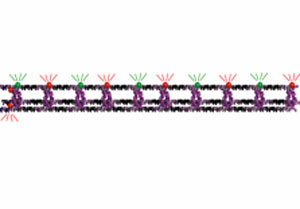| Posted: Feb 23, 2015 |
Building tailor-made DNA nanotubes step by step
|
|
(Nanowerk News) Researchers at McGill University have developed a new, low-cost method to build DNA nanotubes block by block - a breakthrough that could help pave the way for scaffolds made from DNA strands to be used in applications such as optical and electronic devices or smart drug-delivery systems.
|
|
Many researchers, including the McGill team, have previously constructed nanotubes using a method that relies on spontaneous assembly of DNA in solution. The new technique, reported today in Nature Chemistry ("Stepwise growth of surface-grafted DNA nanotubes visualized at the single-molecule level"), promises to yield fewer structural flaws than the spontaneous-assembly method. The building-block approach also makes it possible to better control the size and patterns of the DNA structures, the scientists report.
|
 |
| DNA nanotube
|
|
"Just like a Tetris game, where we manipulate the game pieces with the aim of creating a horizontal line of several blocks, we can now build long nanotubes block by block," said Amani Hariri, a PhD student in McGill's Department of Chemistry and lead author of the study. "By using a fluorescence microscope we can further visualize the formation of the tubes at each stage of assembly, as each block is tagged with a fluorescent compound that serves as a beacon. We can then count the number of blocks incorporated in each tube as it is constructed."
|
|
This new technique was made possible by the development in recent years of single-molecule microscopy, which enables scientists to peer into the nano-world by turning the fluorescence of individual molecules on and off. (That groundbreaking work won three U.S.- and German-based scientists the 2014 Nobel Prize in Chemistry.)
|
|
Hariri's research is jointly supervised by chemistry professors Gonzalo Cosa and Hanadi Sleiman, who co-authored the new study. Cosa's research group specializes in single-molecule fluorescence techniques, while Sleiman's uses DNA chemistry to design new materials for drug delivery and diagnostic tools.
|
|
The custom-built assembly technique developed through this collaboration "gives us the ability to monitor the nanotubes as we're building them, and see their structure, robustness and morphology," Cosa said.
|
|
"We wanted to control the nanotubes' lengths and features one-by-one," said Sleiman, who holds the Canada Research Chair in DNA Nanoscience. The resulting "designer nanotubes," she adds, promise to be far cheaper to produce on a large scale than those created with so-called DNA origami, another innovative technique for using DNA as a nanoscale construction material.
|

